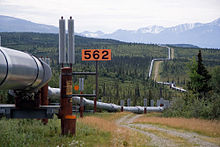Other
Oil pipeline winding through cold Alaskan country-side. In the background are mountains, partly snow-capped
Trans-Alaska Pipeline for crude oil
Pipeline transport sends goods through a pipe, most commonly liquid and gases are sent, but pneumatic tubes can also send solid capsules using compressed air. For liquids/gases, any chemically stable liquid or gas can be sent through a pipeline. Short-distance systems exist for sewage, slurry, water and beer, while long-distance networks are used for petroleum and natural gas.
Cable transport is a broad mode where vehicles are pulled by cables instead of an internal power source. It is most commonly used at steep gradient. Typical solutions include aerial tramway, elevators, escalator and ski lifts; some of these are also categorized as conveyor transport.
Spaceflight is transport out of Earth's atmosphere into outer space by means of a spacecraft. While large amounts of research have gone into technology, it is rarely used except to put satellites into orbit, and conduct scientific experiments. However, man has landed on the moon, and probes have been sent to all the planets of the Solar System.
Suborbital spaceflight is the fastest of the existing and planned transport systems from a place on Earth to a distant other place on Earth. Faster transport could be achieved through part of a Low Earth orbit, or following that trajectory even faster using the propulsion of the rocket to steer it.
http://en.wikipedia.org/wiki/Transport




